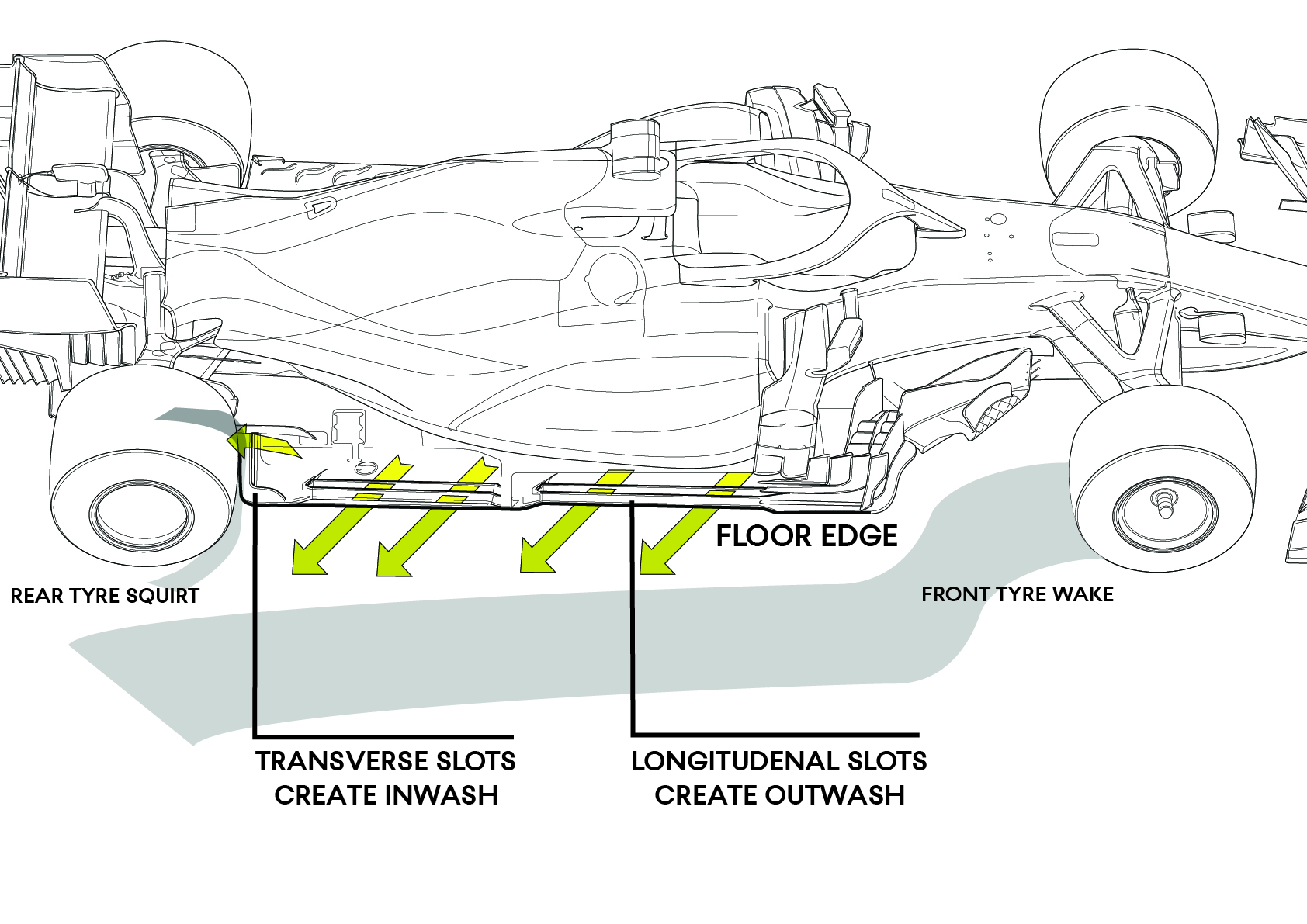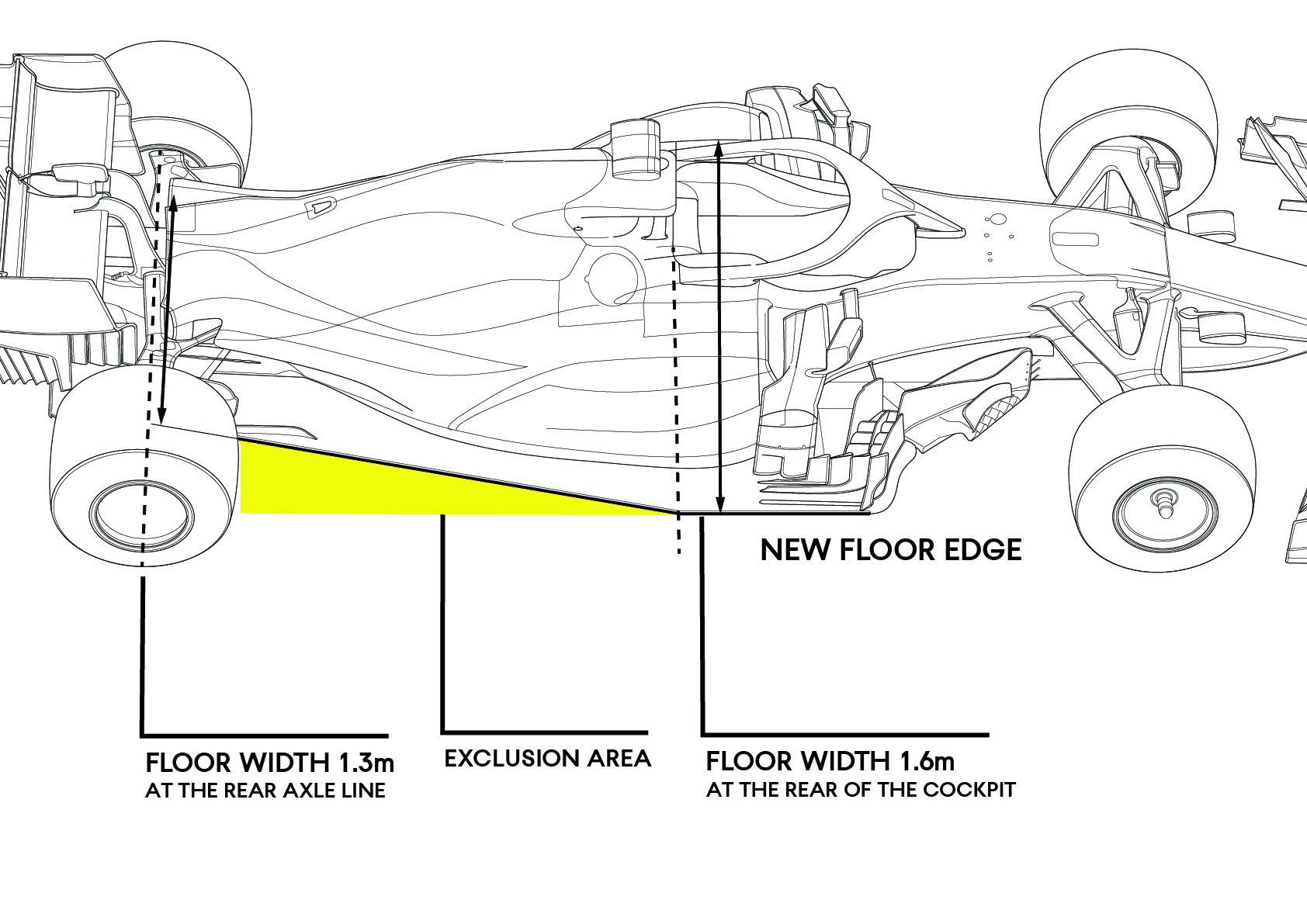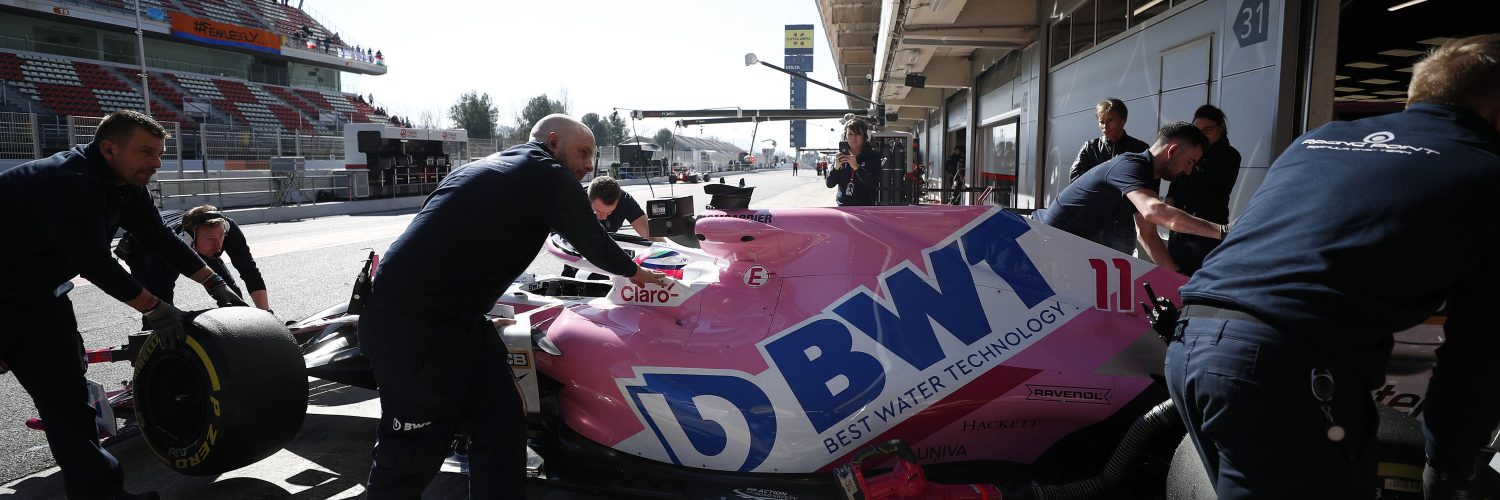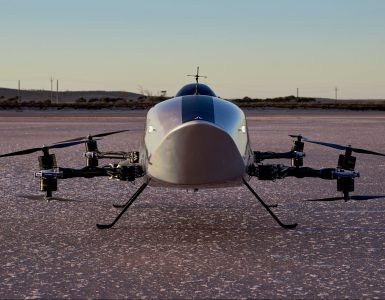As the F1 design offices swing back into action this week, after the enforced shut down during the Covid-19 pandemic, a pragmatic series of rule changes have been agreed between the teams and the FIA. It had already been agreed that the major technical changes for 2021 would be pushed back by a year, leaving the as yet unraced 2020 cars to race into a second season in 2021. As the teams struggle with the financial impact of the pandemic, these changes are primarily aimed at rationalising costs through the next two seasons.
This new announcement sets out the limited number of changes allowed to the cars for the truncated 2020 season and throughout 2021. Additionally, there will be a technical change to the floor design of the 2021 cars and a revised aerodynamic testing restriction system enforced.
Design freeze
The first change is to limit what parts can be changed on the 2020 cars, as they race over the next year and a half. Each team has, of course, already developed a car in readiness for the 2020 season. While the cars have yet to race, indeed they have only tested for a mere six days, the teams will have had an ongoing development programme in place before the FIA enforced shut down. Its likely that without this, the teams will have prepared a completely new aero package and responded to emerging design innovations (such as Mercedes DAS). Even with the shutdown interrupting this ongoing process, the teams will now have time to sign off new parts for the season’s potential start in July. As a result, much of the testing and Melbourne spec hardware may never see the track again.
To cap this rush to bring new parts to Austria and prevent an expensive development race through the compressed season, there will now a design freeze of specific components, summarily listed by the FIA as: chassis, gearbox, a number of mechanical components and impact structures. This sort of hardware is not often changed through a season, but it is expensive to design and manufacture, typically for small gains (innovations such as DAS excepted). So, this intervention seems entirely logical. In order to provide the teams a degree of flexibility, there will be a token system introduced to allow limited number of modifications. In the newly published regulations these parts are termed ‘Homologated Components’ (HC).
This design freeze has been used in F1 many times. Changes may be made for safety, reliability or cost reasons, as well as changes in supplier, drivers or regulations. Any changes need to be done with FIA approval, to ensure teams don’t flout the intention of these rules. Each part\sub assembly in the full FIA list (published in the technical regulations on the FIA website), has a deadline to be homologated for the first race of the season along with a cost in tokens. Teams will only be able to spend two development tokens in 2020 and another two in 2021, thus one larger assembly or two smaller parts may be changed each season.
Moreover, this design freeze will extend into 2021, so teams will not be able to design entirely new monocoques gearboxes etc, so the 2021 cars will race in near identical ‘under the skin’ specification to 2020. Again, this is a common-sense approach to the current situation, as the return on the team’s investment to develop the 2020 car will be extended into another year.
If the outer aerodynamic skin of the car develops at a phenomenal rate, the ‘under the skin’ hardware tends to evolve more slowly. Although with every new season, despite many of these parts looking near identical year on year, they are entirely redesigned, meaning huge amounts money spent on design and manufacturing, for incremental gains. This has been a long overdue cost saving regulation, to life these parts at over a season’s worth of racing.
With the foreshortened 2020 season, the hugely expensive power units will also be subject to development restrictions. Part of this will be the introduction of Power Unit test bench restrictions, so that manufacturers will have to spend less time and money running Power Units on their dynos. With this in mind, the FIA have allowed a further increase in the car’s minimum weight, raising it by a few kilogrammes to a considerable 749kg.
Its clear that the car’s aero bodywork is exempt from this rule, so cars will still look a little different and teams will be able to develop new bodywork through 2020 and 2021. Albeit this will be subject to tighter controls on aerodynamic testing.
Floor simplification
Despite the design freeze and reduction in aero testing, the 2021 cars will inevitably benefit from performance upgrades, this will apply greater cornering forces to the Pirelli tyres. Already the 2020 season was planned to run with the same tyres as in 2019 and this tyre specification will now extend into 2021. As there will not be any tyre development from Pirelli through this period, the FIA will need to ensure the cars do not overstress the 2019 tyre design. To achieve this the 2021 cars will have to run a simplified floor edge design, which should stem the growth in downforce.
 The floor edge is a nice contained area to choose for the rule change, one that has also seen increased development in recent seasons. We are talking about the long sides of the stepped floor, projecting out from under the sidepod. These are the broadest part of the car and were widened as part of the 2017 aero performance upgrade to 1.6 metres. The floor in this area has multiple roles. Firstly, the floor has high pressure above it and low pressure below, helping to create over a third of the car’s downforce. Being wider, the floor has more surface area to create downforce and deters unwanted high pressure air passing underneath the car. At the floor’s intersection with the rear tyre, teams trim the floor as tightly as possible around the tyre to prevent unwanted ingress of high-pressure air to the diffuser area.
The floor edge is a nice contained area to choose for the rule change, one that has also seen increased development in recent seasons. We are talking about the long sides of the stepped floor, projecting out from under the sidepod. These are the broadest part of the car and were widened as part of the 2017 aero performance upgrade to 1.6 metres. The floor in this area has multiple roles. Firstly, the floor has high pressure above it and low pressure below, helping to create over a third of the car’s downforce. Being wider, the floor has more surface area to create downforce and deters unwanted high pressure air passing underneath the car. At the floor’s intersection with the rear tyre, teams trim the floor as tightly as possible around the tyre to prevent unwanted ingress of high-pressure air to the diffuser area.
More recently, the wider floor and freedom in the openings allowed within it has been a fruitful development area. Teams have made this area massively more complex than ever before with a series of longitudinal slots and fins along the edge, with transverse slots just ahead of the rear tyre. These serve two functions, the edges longitudinal slots and fins crate outwash helping to push the front tyre wake away from the rear of the car, while the rear tyre slots create inwash to prevent the rear tyre’s wake entering the diffuser.
The FIA’s plan for 2021 is to simplify the floor edge, ridding it of the assortment of slots and fins, while also tapering the floor inwards along its length. The reduction in plan area will probably be of little direct consequence to creating downforce. But the tapered shape and simpler edge will have a huge effect on the diffuser’s performance, and this will be effects that rob the car of performance. Air passing along the flank of the car, with less outwash from the floor slots will naturally want to be pulled into the diffuser and coke bottle area. While the airflow hitting the rear tyre near ground level while have less of a straightening effect from the tyre slots and will send airflow sideways into the diffuser, an effect called ‘tyre squirt’.
 Perhaps offsetting some of these negative effects will be the tapered shape to the floor in plan view. Air passing over the floor, will meet the floor edge and will be pulled into the low pressure area below, creating a vortex in the process, teams might want to encourage this, by strengthening and directing the vortex in-between the rear tyre and diffuser, to offset the front tyre wake and rear tyre squirt effects. To do this the airflow will need to be prepared upstream, so despite the floor edge being a neat contained area for the rule change, the impact will be revised bargeboards and floor leading edge designs, all aiming to get the flor vortex working. So, the actual changes will be far more wide reaching and expensive than just a newly moulded floor edge.
Perhaps offsetting some of these negative effects will be the tapered shape to the floor in plan view. Air passing over the floor, will meet the floor edge and will be pulled into the low pressure area below, creating a vortex in the process, teams might want to encourage this, by strengthening and directing the vortex in-between the rear tyre and diffuser, to offset the front tyre wake and rear tyre squirt effects. To do this the airflow will need to be prepared upstream, so despite the floor edge being a neat contained area for the rule change, the impact will be revised bargeboards and floor leading edge designs, all aiming to get the flor vortex working. So, the actual changes will be far more wide reaching and expensive than just a newly moulded floor edge.
Aerodynamic Testing Restrictions
For 2020, a reduction in aerodynamic testing (ATR) for cost reasons.
For 2021, a further reduction in aerodynamic testing, and the introduction of a bias between championship position and ATR limitations. The ATR bias will be linear between P1 and P10.
For 2022, a number of key specific aspects of the regulations have been set out, including curfews, restricted number components (RNCs), scrutineering, and parc fermé prescriptions. These regulations work as a package together with the 2022 Technical Regulations that were approved by the World Council on 30 March 2020 and will be part of an ongoing review and refinement process throughout 2020 and 2021.
Teams are already limited in the amount of aero testing they can do in both the wind tunnel and CFD. This has hit the bigger teams as they are constrained by the upper limit of the ATR’s, while smaller teams were not at a level where they did enough testing to hit the restrictions.
But with aero departments as large as the main design office and requiring wind tunnels and CFD clusters, the aero department is huge consumer of the team’s overall R&D budget. Making further cuts is in line with the aims of this batch of regulation changes to ease the development costs over the 2020/2021 seasons.
Current ATR sets out how many wind tunnels runs can be used and in which nominated tunnel, along with limits on CFD computing processing time. There being a calculation to apportion the total testing allowed between the two technologies.
For 2020 there are further cuts in ATR, which should help close the gap between the bigger and smaller teams, as well reduce budgets in the short term. Then for 2021 the cost cap will add another layer of cost restrictions over and above the ATR. However, the two will work concurrently, so teams could not decide to focus sits R&D budget on aero, for example at the expense of mechanical design. There will be an upper limit on aero testing and as the restrictions get tighter over the coming seasons, teams will all end up with the same elver of aero testing regardless of their development philosophy. Equally, the new ATR sets out a maximum number of runs in the wind tunnel and CFD (the latter new for 2021). This is a fixed allocation, so again a team cannot choose to overly focus on one approach over the other.
With such tight restrictions, the obvious question for any team will be, how to maximise the aero testing within the specific rules? As the restrictions have already been in pace for a number of years and monitored by the FIA, there have not been any infringements brought to light. There may be a temptation going forwards to hive off testing to other facilities not monitored by the FIA, but this would of course be illegal, and any team caught doing this would be heavily punished. Coincidentally, the FIA have also recent announced a ‘whistle blower’ process with their Ethics and Compliance Hotline website. This will be a process where individuals can report any concerns to the FIA for investigation. This will apply to the budget cap, regulations and even doping. Given this and the continual churn of staff between teams, any wrongdoing will soon be brought to light. Its more likely that other more subtle means to maximise testing under the ATR will be looked at. Even with the current restrictions teams able to invest in new technologies in their wind tunnels or CFD capabilities will have an upper hand over lesser funded teams simply running existing processes and hardware. But overall, the newly announced ATR will be a step forwards in cutting costs and equalising the aero design process between the teams.
The FIA has gone even further and introduced a means to level the playing field even further, with a Balance of Performance (BoP) system from 2021. Starting from the baseline aero testing limit set out for 2020, the teams will only be able to use a percentage of that testing dependant on their finishing position in the previous year’s constructors championship. This way the leading teams get a handicap, to hinder their dominance of the top3 positions and the lesser teams get more testing (if they can afford it) to catch up. A simple scaled formula is applied, in 2020 the top teams only gets 90% of the ATR limit, while the last team gets 112.5% of the testing limit. This gap widens in 2022, with 70% and 115% respectively.
This may be seen as unfair in penalising teams with greater budgets and success, but BoP has been applied in other series, with some success. BoP will certainly go further to equalise the teams, but one has to remember that if a Top3 team cannot exploit their budget with Aero testing, then their focus will go elsewhere. While its true Aero performance provides a greater reward in lap time reduction than other variables that the team can control, directing R&D into lesser areas will also bring performance.
Overall, the FIA has acted swiftly and with unanimous agreement from the teams to construct a pragmatic and enforceable means to cut costs and balance the field. How, the process goes will depend on how the teams adhere the intention of the rules, the rigour these measures are enforced by the FIA and the prevailing financial climate. It unusual that such a wide consensus is reached and continues within F1 before, someone seeks an opportunity to find an advantage elsewhere.




